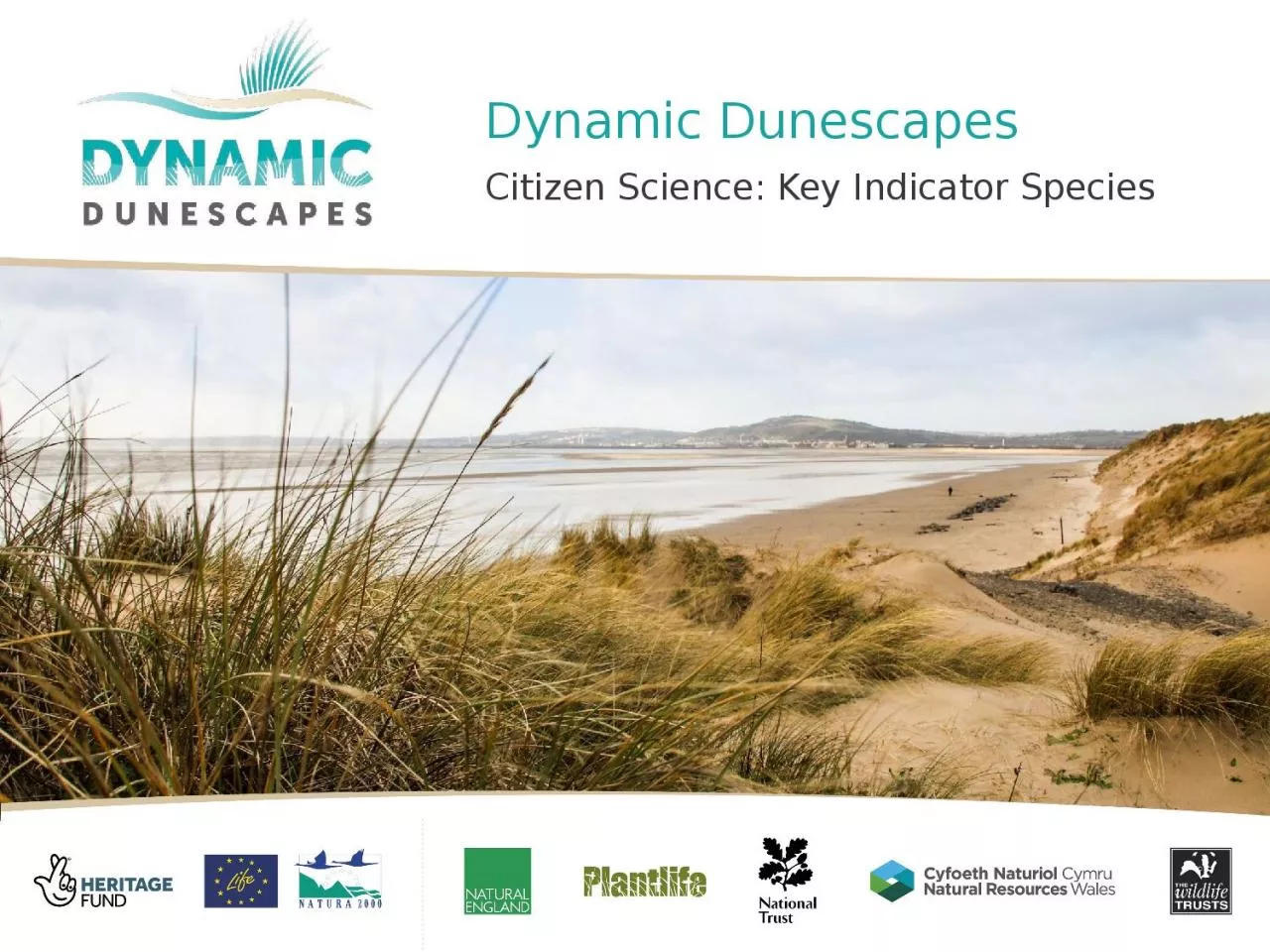

Science Key Indicator Species Plants are essential indicators of how healthy sand dunes are Sand dunes are home to a variety of plants which are vital for biodiversity Some dunes may be acidic or some calciferous meaning they will support a variety of different species ID: 1022173
Download Presentation The PPT/PDF document "v Dynamic Dunescapes C itizen" is the property of its rightful owner. Permission is granted to download and print the materials on this web site for personal, non-commercial use only, and to display it on your personal computer provided you do not modify the materials and that you retain all copyright notices contained in the materials. By downloading content from our website, you accept the terms of this agreement.
1. vDynamic DunescapesCitizen Science: Key Indicator Species
2. Plants are essential indicators of how healthy sand dunes are. Sand dunes are home to a variety of plants which are vital for biodiversity. Some dunes may be acidic or some calciferous meaning they will support a variety of different species. Negative indicators are plants that may indicate a decline in the health of our dunes putting the wildlife there at risk.Key Indicator Species
3. The following tables will guide you on which species to look out for when undertaking your surveys.We have put together some tables of positive and negative indicator species that you may find in your quadrats in different habitat types on the dunes. You can refer to the Dynamic Dunescapes App for help ID’ing species and descriptions.You may find it useful to download the i-Record App to help identify plants outside this survey.Key Indicator Species
4. Strandline, embryo and mobile dune key indicator speciesMobile dune positive indicatorsMobile dune negative indicatorsSea sandwort (Honkenya peploides)Common ragwort (Senecio jacobaea)Common saltwort (Salsola kali)Spear thistle (Cirsium vulgare)Marram grass (Ammophila arenaria)Creeping thistle (Cirsium arvense)Sea rocket (Cakile maritima)Common nettle (Urtica dioica)Sea holly (Eryngium maritimum)Ryegrass (Lolium perenne)Key Indicator Species Ragwort
5. Fixed dune grassland positive indicatorsFixed dune grassland negative indicatorsLady’s bedstraw (Galium verum)Bramble (Rubus fruticosus)Eyebright (Euphrasia officinalis)Spear thistle (Cirsium vulgare)Bird’s-foot trefoil (Lotus corniculatus)Common nettle (Urtica dioica)Self heal (Prunella vulgaris)Sea buckthorn (Hippophae rhamnoides)Yellow rattle (Rhinanthus minor)Rose species (Rosa spp.)Cladonia lichensTravellers joy (Clematis vitalba)Fixed dune acidic grassland positive indicatorsFixed dune acidic grassland negative indicatorsSheep's bit (Jasione montana)Spear thistle (Cirsium vulgare)Common cat's ear (Hypochaeris radicata)Rose species (Rosa spp.)Buck's horn plantain (Plantago coronopus)European gorse (Ulex europeus)Squirrel-tail fescue (Vulpia bromoides)Ling (Calluna vulgaris)Marram (Ammophila arenaria)Heath star-moss (Campylopus introflexus) Pirri-pirri bur (Acaena nova-zelandia) Rhododendron (Rhododendron ponticum)Key Indicator Species Semi-fixed and fixed dune key indicator speciesBird’s-foot trefoil
6. Health positive indicatorsHealth negative indicatorsMarram (Ammophila arenaria)Sycamore (Acer pseudoplatanus)Sand sedge (Carex arenaria)Holly (Ilex aquifolium)Sheep's bit (Jasione montana)Scot's pine (Pinus sylvestris)Common cat's ear (Hypochaeris radicata)Heath star-moss (Campylopus introflexus)Cladonia lichens (Cladonia spp) Juniper hair-cap moss (Polytrichum juniperinum) Key Indicator Species Dune heath key indicator speciesCladonia lichens
7. Dune slacks positive indicatorsDune slacks negative indicatorsBird’s foot trefoil (Lotus corniculatus)Creeping thistle (Cirsium arvense)Creeping willow (Salix repens)Common nettle (Urtica dioica)Water mint (Mentha aquatica)Ragwort (Senecio jacobaea)Marsh pennywort (Hydrocotyle vulgaris)Bracken (Pteridium aquilinum)Self-heal (Prunella vulgaris) Bog pimpernel (Anagallis tenella)Sea buckthorn (Hippophae rhamnoides) *Pointed Spear moss (Calliergonella cuspidata) Liverworts (e.g. Aneura pinguis) Key Indicator Species Dune slack key indicator speciesSea buckthorn
8. Calcareous dune Nitrogen sensitive speciesCalcareous dune Nitrogen loving speciesKidney vetch (Anthyllis vulneraria)Cocksfoot (Dactylis glomerata)Harebell (Campanula rotundifolia)Silverweed (Potentilla anserina)Biting stonecrop (Sedum acre)White clover (Trifolium repens)Devil’s bit scabious (Succisa pratensis)Curled dock (Rumex crispus)Hare’s foot clover (Trifolium arvense)Creeping thistle (Cirsium arvense) Sow-thistle (Sonchus spp.)Acidic dune nitrogen sensitive speciesAcidic dune nitrogen loving speciesMossy stonecrop (Crassula tillea)Cocksfoot (Dactylis glomerata)Early hair-grass (Aira praecox)Silverweed (Potentilla anserina)Lesser Cudweed (Filago minima)White clover (Trifolium repens)Field woodrush (Luzula campestris)Greater plantain (Plantago major)Dune fescue (Vulpia fasciculata)Cleavers (Galium aparine) Sow-thistle (Sonchus spp.)Key Indicator Species Indicators of nitrogen deposition: Fixed dune grasslandKidney vetch
9. Dune slack Nitrogen sensitive speciesDune slack Nitrogen loving speciesBird’s foot trefoil (Lotus corniculatus)Ground ivy (Glechoma hederacea)Blue-green / glaucous sedges (Carex flacca, Carex panicea, Carex nigra)Creeping buttercup (Ranunculus repens)Marsh orchids (Dactylorhiza spp.)Woody nightshade (Solanum dulcamara)Devil’s bit scabious (Succisa pratensis)Hemp agrimony (Eupatorium cannabinum)Liverworts (e.g. Aneura pinguis)Creeping thistle (Cirsium arvense) Sow-thistle (Sonchus spp.)Disturbance Indicators of nitrogen deposition: dune slacksMarsh orchids
10. vDynamic Dunescapeswww.dynamicdunescapes.co.uk@dynamicdunes